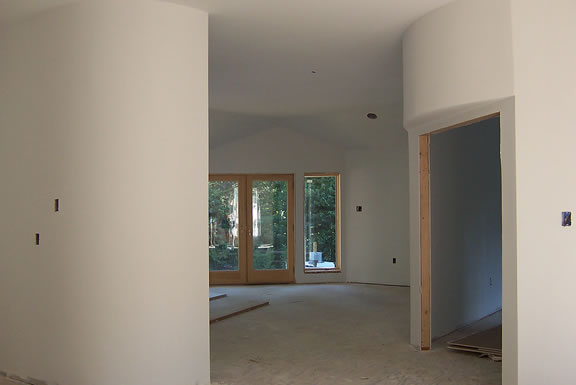Reliable Drywall Repair Techniques to Recover Your Wall surfaces
Reliable Drywall Repair Techniques to Recover Your Wall surfaces
Blog Article
Drywall Setup Made Easy: Tips for Perfect Results
Drywall installment is typically regarded as a complicated task, yet with the right strategy and understanding, it can come to be a workable undertaking. Mastering strategies for reducing, hanging, and ending up drywall can substantially influence the outcome.
Picking the Right Materials
Choosing the ideal materials for drywall setup is crucial to accomplishing a durable and visually pleasing surface. drywall fort worth. The primary component, drywall sheets, normally can be found in various thicknesses, with 1/2-inch sheets being typical for indoor walls. For areas requiring extra wetness resistance, such as bathrooms or kitchens, take into consideration utilizing environment-friendly board or concrete board, which are specially developed to endure humidity

In addition, choosing the ideal fasteners-- either screws or nails-- is vital for protecting the drywall to the framework. Drywall screws are normally preferred for their holding power and decreased risk of popping. Lastly, take into consideration the complements such as guide and paint, which not just improve the appearance but also shield the drywall from dampness and wear.
Preparing the Installation Location
Before beginning the drywall setup procedure, it is vital to prepare the installation location completely. A tidy work area decreases the risk of damages to existing things and enables for effective movement throughout installation.
Following, evaluate the walls and ceiling for any kind of imperfections, such as cracks, holes, or mold. Address these concerns beforehand; patch any kind of damages and enable enough time for repair work to completely dry. Additionally, guarantee that electric outlets, buttons, and plumbing are correctly placed and represented, as this will certainly influence drywall placement.
Think about the ecological problems. A secure temperature level and moisture degree are essential for ideal attachment and performance of the drywall products. If needed, use a dehumidifier or heater to create suitable conditions.
Trimming and Hanging Drywall
The key to efficient drywall setup exists in the exact cutting and hanging of the panels. Utilize a straight side and an energy blade to score the drywall along your dimensions, then snap it along the scored line for a clean break.

Always function from the top down and left to right, making certain that you maintain a staggered pattern to improve security. Correctly hanging the drywall establishes the foundation for a smooth coating, eventually bring about exceptional outcomes in your drywall project.
Taping and Mudding Methods
While correct cutting and hanging of drywall sets the phase, the next vital action involves grasping taping and mudding strategies to ensure a seamless surface. Insulation is crucial for reinforcing joints and stopping splits; it includes installing tape into the applied joint substance (mud) Start with a top quality fiberglass or paper tape, using the tape over the joint and pushing it right into the wet mud using a taping knife, guaranteeing no air bubbles remain.
Once the tape remains in location, apply a thin layer of joint compound over the tape, feathering the sides to create a smooth transition to the drywall surface. Allow this layer to dry completely before sanding it lightly to remove flaws. Repeat this process, applying extra layers of mud as required-- normally a couple of layers-- while slowly broadening the application area with each layer to accomplish a seamless look.
After the final layer dries out, sand the surface area with a fine-grit sandpaper up until smooth. drywall installation. Keep in mind to wear a mask during sanding to prevent inhaling dust particles. Understanding these taping and mudding strategies is essential for helpful resources attaining a professional-quality coating in your drywall setup
Completing Touches for Perfection
Achieving a remarkable drywall installment exceeds taping and mudding; her explanation it culminates in the ending up touches that boost the general look. These final steps are crucial in ensuring a professional-grade coating that improves the aesthetic appeals of your space.
Begin by sanding the dried out joint compound to develop a smooth surface. Use a fine-grit sandpaper and a fining sand block or pole sander for optimum control. Pay specific attention to sides and edges, as these areas often tend to need more thorough work. After fining sand, wipe down the walls with a wet fabric to get rid of any type of dust bits, ensuring a tidy surface for paint.
Following, apply a guide specifically created for drywall. This action is vital, as it aids seal the joint substance and gives an uniform base for the overcoat. As soon as the primer dries out, inspect for any type of blemishes, and touch up as needed.
Verdict
In final thought, successful drywall setup pivots on the cautious choice of products, thorough preparation of the installation area, and precise execution of cutting and hanging techniques. Mastery of taping and mudding procedures is vital for attaining a smooth coating.
Drywall setup is commonly viewed as an overwhelming job, yet with the appropriate strategy and expertise, it can end up being a workable venture.Selecting the appropriate materials for drywall installment is critical to attaining a long lasting and visually pleasing coating.Before beginning the drywall installation procedure, it is necessary to prepare the setup area extensively. Understanding these taping and mudding methods is vital for accomplishing a professional-quality finish in your drywall installment.
In verdict, successful drywall installation pivots on the cautious option of products, thorough prep work of the setup area, and specific execution of reducing and hanging methods.
Report this page